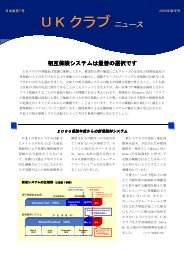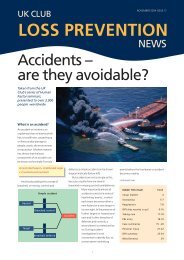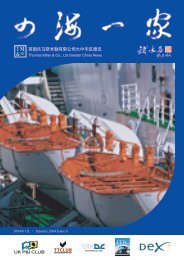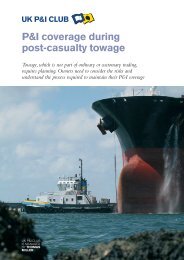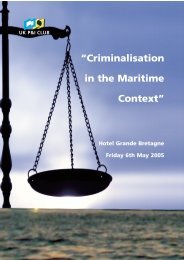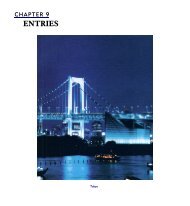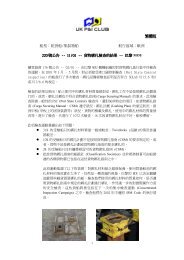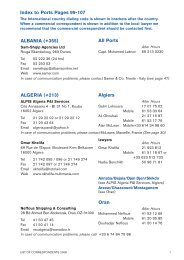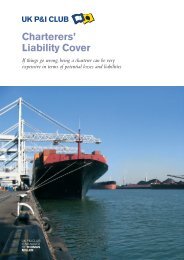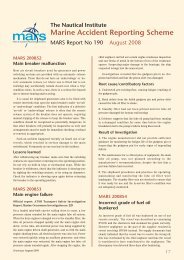Port State Control A/W - UK P&I Members Area
Port State Control A/W - UK P&I Members Area
Port State Control A/W - UK P&I Members Area
- No tags were found...
Create successful ePaper yourself
Turn your PDF publications into a flip-book with our unique Google optimized e-Paper software.
PORT STATE CONTROL AND THE USA●●International Convention on Standards of Training,Certification and Watchkeeping for Seafarers 1978, asamended (STCW 78).Convention on the International Regulations for PreventingCollisions at Sea 1972, as amended (COLREG 72).Booklets covering hull or machinery qualifications. In addition,marine inspectors and/or boarding officers must havecompleted the appropriate Marine Safety Training &Qualification Booklets for the type of ship being examined.Boarding teams conducting Priority I boardings, annualfreight, tanker and passenger ship examinations, biennial● Merchant Shipping (Minimum Standards) Convention, 1976(ILO Convention 147).Certificate of Compliance examinations and quarterlypassenger ship re-examinations must include a marine●International Convention Relating to Intervention on theHigh Seas in Cases of Oil Pollution Casualties, 1975 and theProtocol relating to Intervention on the High Seas in Casesof Marine Pollution by Substances other than Oil, 1983.inspector. At a minimum, such boarding teams should consistof at least two Coast Guard members, at least one of whommust be a qualified <strong>Port</strong> Safety Boarding Officer (E1), or aqualified Assistant Marine Inspector (FA or FB).When conducting at-sea boardings in cooperation with <strong>Area</strong>PORT STATE CONTROL EXAMINATIONSForeign ship examinations may be initiated by the USCG,requested by another flag state administration on the basis ofinformation regarding a potential substandard ship, or basedon information regarding a substandard ship provided by amember or members of a ship’s crew, a professional body, anor Group commands outside of the Marine Safety Programme,boarding teams will be provided by the Marine Safety Office, orjointly by the Captain of the <strong>Port</strong> and Marine Inspection Office.However, operational commanders have the discretion to makeup the boarding teams to meet operational situations,including the use of law enforcement qualified personnel, asnecessary, to ensure the safety of the boarding team.association, a trade union or any other involved individual. TheUSCG, on their website, go on to explain:“<strong>Port</strong> <strong>State</strong> <strong>Control</strong> examinations are not intended to beanalogous to an inspection for certification of a US flaggedvessel. Rather, they are intended to be of sufficient breadth anddepth to satisfy a boarding team that a ship’s major systemsare in compliance with applicable international standards anddomestic requirements, and that the crew possesses sufficientproficiency to safely operate the vessel.”The initial examination is designed to verify whether therequired certificates are aboard and valid, and whether theship conforms to the conditions required for issuing therequired certificates. This is accomplished by a walk throughexamination and visual assessment of a ship’s relevantcomponents, certificates and documents, and may beaccompanied by limited testing of systems and the crew. If thisexamination reveals questionable equipment, systems, or crewincompetence, the boarding team may conduct furtheroperational tests and examinations.SELECTING A SHIP FOR INSPECTION – THEBOARDING PRIORITY MATRIXUntil 1994, the USCG’s ship boarding programme was largely adhoc, but they now have developed a Boarding Priority Matrix aspart of their effort to systematically determine the probable riskposed by non-US ships calling at US ports. This Matrix is used todecide which ships <strong>Port</strong> <strong>State</strong> <strong>Control</strong> inspectors should boardon any given day, in any given port. Ships are assessed in eachcategory and then summed for a total point score. Thisnumerical score, along with other performance based factors,determines a ship’s boarding priority from Priority I through IV.In developing this points system, the US Coast Guard hasidentified five features which directly influence a ship’soperational condition and compliance with international safetyand environmental protection standards. These are,1. Flag states2. Classification societies3. Owner and Operators List4. Ship Type, andBOARDING TEAMS5. HistoryBoarding teams usually consist of a marine inspector and oneor more boarding officers. As a minimum, a marine inspectorThe first three are particularly significant and are dealt with asexplained below:must have completed the Marine Safety Training & Qualification30




